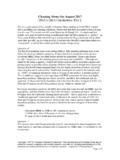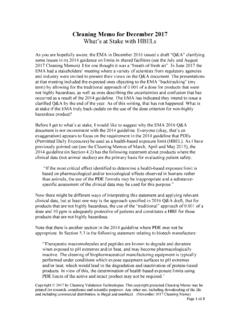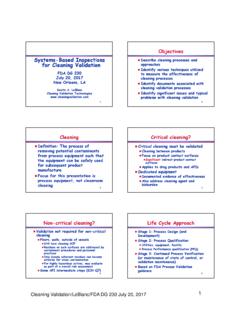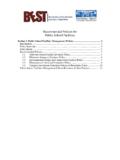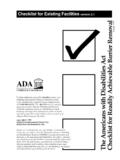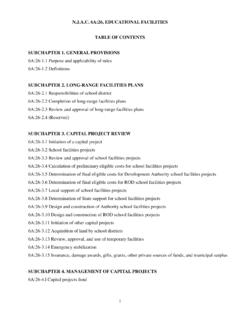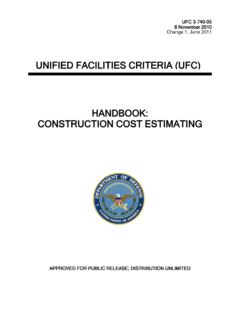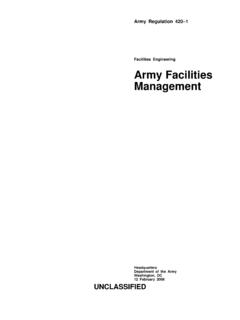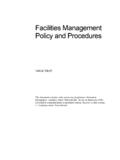Transcription of Cleaning Memo 2015-05
1 Copyright 2015 by Cleaning Validation Technologies. This copyright protected Cleaning memo may beprinted for research, compliance and scientific purposes. Any other use, including downloading of the fileand including commercial distribution, is illegal and unethical. (May 2015 Cleaning memo )Page1of3 Cleaning memo for May 2015 EMA on Limits for Shared Facilities Part 3 This is the third in a series of Cleaning Memos discussing the finalized version of EMA s Guideline on setting health based exposure limits for use in risk identification in themanufacture of different medicinal products in shared facilities . It discusses still moreadditional specific issues in the November Gaps for Reproductive and Developmental ToxicityThe guideline refers to the possible lack of animal data on reproductive anddevelopmental toxicity (which I will just refer to as reproductive toxicity ), as well as gaps in the scientific knowledge for commercial products.
2 One solution proposed is the NOAEL of a sub-chronic/chronic study may be used in the calculation of a PDEwith application of an additional adjustment factor ( 10) if adequately justified. I amsomewhat confused by this suggestion. If there is no animal reproductive toxicity, what isthe NOAEL referring to? Is it a NOAEL onanothercritical effect, with the application ofan additional safety factor? Or what?A second option given is the read-across approach, where data from related compoundsmay be used. The read-across approach is utilized in the EU in its REACH initiative tocontrol chemical entities in Europe. One way to think of the read-across approach isthat it is a form of grouping, whereby data from one chemical compound is applied toother similar compounds. In the case in hand, data for reproductive toxicity for a givencompound maybe used for another similar compound without formal studies to generatesuch data.
3 The key, of course, is to decide what issufficiently similarthat such anapproach is applicable. This does require the input of a toxicologist with experience inreproductive toxicology. (Note that one of the rationales for the read across approach is toreduce animal testing. Furthermore, while the EMA gives the application of the read-across approach in the context of reproductive toxicity, companies may want to considerthat approach for other toxicity concerns.)Investigational Medicinal Products (IMPs)This section deals with Phase I/II products that may have limited data. EMA presents an alternative approach using default values tiered depending onpotency and toxicity. Itgives three references, but perhaps the most useful for pharmaceutical manufacturerswould be the 2005 paper by Dolan et al, since it has a pharmaceutical focus.
4 In that paper,three daily intake tiers are proposed for chemicals withlimitedtoxicity data:1 g/day for compounds thatmay becarcinogenic10 g/day for compounds thatmay bepotent or highly toxic100 g/day for compoundsnotlikely to be potent, highly toxic, or carcinogenicAlthough not mentioned by the EMA, it would seem that the read-across approach mayalso be applicable 2015 by Cleaning Validation Technologies. This copyright protected Cleaning memo may beprinted for research, compliance and scientific purposes. Any other use, including downloading of the fileand including commercial distribution, is illegal and unethical. (May 2015 Cleaning memo )Page2of3 Reporting of PDE Determination StrategyIn this section the EMA outlines documentation principles to be followed in determininga PDE. It includes a comprehensive literature search, the critical endpoints, the pivotalanimal and human studies used for determination of the PDE, and a rationale forselection of adjustment factors.
5 The EMA also provides a template for a cover page forclear communication to regulators of the results and strategy used. Note that while thissection ostensibly applies only to the PDE value, it probably is meant also for any safethreshold value which may be determined by other means or approaches. [Note that thissection was called Risk Assessment Report (a more general description) in the draftEMA document, but was changed to Reporting of the PDE determination strategy inthe final version.]Other ApproachesWhile the EMA gives several options for safe threshold values, such as the PDEapproach and the TTC approach, and while it also gives cases where PDEs may not beapplicable, it also states that other approaches may be accepted if adequately justified .For example, in the executive summary, the EMA states: Deviation from the main approach highlighted in this guideline to derive suchsafe threshold levels could be accepted if adequately justified.
6 Similar wording is repeated several times in the document in different contexts, suchas at the end of Section 1 (Introduction) and in the middle of Section (oncalculation of PDE values).Note: Both Risk-MaPP and the EMA refer to a safe threshold value . However, thatphrase is used differently in each document. For the EMA a safe threshold value is ageneric or umbrella phrase that would include PDE and TTC values. In Risk-MaPP asafe threshold value is a valuederived from the ADEwhich represents one of threelimits: the total carryover to the next product, the amount per swab, or a concentrationin a rinse solution (values that I commonly call L2, L4a, and L4c, respectively).A More Scientific ApproachThose of you who have followed my critique of Risk-MaPP know that one of myobjections to it involves various statements made by the Rick-MaPP authors that thetraditional way of setting limits (such as of a dose) is non-scientific andarbitrary.
7 Fortunately, the EMA doesnotfollow that approach, but rather calls itsapproach more scientific . I don t object to that terminology (because at leastconcedes that there is some science before the traditional approach). However, I thinka more helpful statement would be that the health-based limit ismore precisethan of a dose criterion. That is, the dose criterion is a one size fits all approach for actives that arenothighly hazardous. Using a health-based approachmay allow manufacturers to set higher limits for certain actives that are not highlyhazardous, as well as to manufacture highly hazardous drugs in 2015 by Cleaning Validation Technologies. This copyright protected Cleaning memo may beprinted for research, compliance and scientific purposes. Any other use, including downloading of the fileand including commercial distribution, is illegal and unethical.
8 (May 2015 Cleaning memo )Page3of3 Definition of critical effectWhile the EMA does list what is included in critical effects , it does not reallyprovide a clear definition. This probably is how it has to be; it is not unlike mydefinition for a highly hazardous active , where I try to define it by giving EMA states that critical effects include the most sensitive indicator of anadverse effect seen in non-clinical toxicity studies and any clinical therapeutic andadverse effect . This is good, because it clearly establishes that thetherapeutic effectof an activemay bethe critical effect (which is probably the case for most drugactives that are not highly hazardous).This is the last in this series. While these three Cleaning Memos may help youunderstand some of the issues, it is highly recommended that the EMA document becarefully reviewed in order to implement these approaches.
